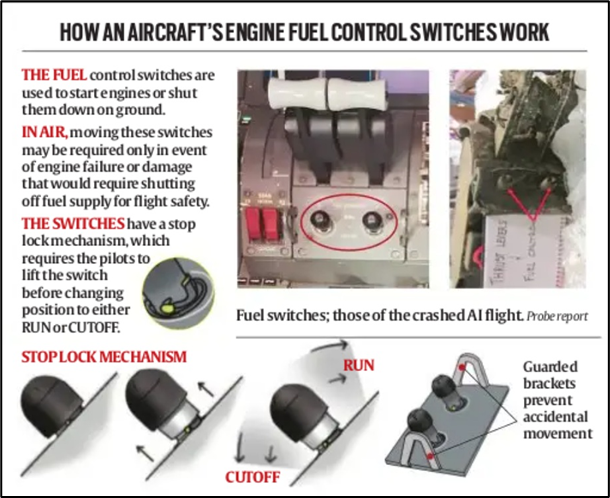Why in news?
The Aircraft Accident Investigation Bureau’s (AAIB) preliminary report on June 12 crash of Air India highlights that both engine fuel control switches moved from ‘RUN’ to ‘CUTOFF’ just after take-off, possibly causing the disaster.
Cockpit recordings reveal one pilot questioning the other about cutting off fuel, which was denied. Both pilots had sufficient flying experience. Investigators are now analyzing flight and voice recorder data to determine how and why the switches were turned off.
What’s in Today’s Article?
- Fuel Control Switches: Critical Engine Safeguards
- Why and How Pilots Use Fuel Switches Mid-Flight
- Honeywell Switches Under Scrutiny, Previously Flagged by FAA
Fuel Control Switches: Critical Engine Safeguards

- Fuel control switches regulate engine fuel flow and require deliberate manual action to move between ‘RUN’ and ‘CUTOFF’.
- Located below the thrust levers on Boeing 787s, these spring-loaded switches require deliberate lifting and shifting between two modes: 'RUN' and 'CUTOFF'.
- Protected by brackets and a stop-lock mechanism, they’re typically operated only on the ground—during engine start-up or shutdown.
- In-flight use occurs only during engine failure or serious damage. Accidental activation is considered nearly impossible.
- Fuel Control Switches: Function, Safety, and Crash Relevance
- Fuel control switches have two positions:
- RUN: Feeds fuel to the engine for normal operation.
- CUTOFF: Cuts off fuel, shutting the engine down.
- Changing positions requires deliberate crew action via a safety mechanism.
- Experts stress these switches are not meant to be moved in-flight except during emergencies.
Why and How Pilots Use Fuel Switches Mid-Flight?
- Pilots move a fuel control switch mid-flight only if an engine fails or is severely damaged. This shuts off fuel to that engine, cutting thrust instantly.
- Normally, only one switch is moved, as modern aircraft can fly with one engine. Shutting down both engines is highly unusual and dangerous.
- Experts stress this is a deliberate, checklist-driven process involving both pilots.
- In AI 171’s crash, both switches moved to 'CUTOFF' shortly after takeoff, starving both engines of fuel.
- Investigators are examining if this was due to human error, mechanical fault, or system failure. The switches are protected against accidental movement with electronic gates and physical brackets.
- Experts Question Possibility of Accidental Fuel Switch-Off
- Aviation experts emphasize it’s nearly impossible for pilots to unintentionally shut off both fuel switches mid-flight, especially during climb.
- While the final cause is still under investigation, the preliminary findings raise concerns over cockpit procedures, safety checks, and potential technical faults.
Honeywell Switches Under Scrutiny, Previously Flagged by FAA
- The fuel control switches (part number 4TL837-3D) are made by Honeywell.
- A 2018 US FAA advisory noted possible locking mechanism faults, but inspections were not mandatory. Air India did not carry out these checks.
- The 2018 advisory flagged potential disengagement of the fuel control switch locking feature on some Boeing aircraft.
- According to the FAA, disengaged locking could let switches move unintentionally, potentially causing in-flight engine shutdown.
- The AI-171 cockpit recording suggests neither pilot knowingly moved the switches.










